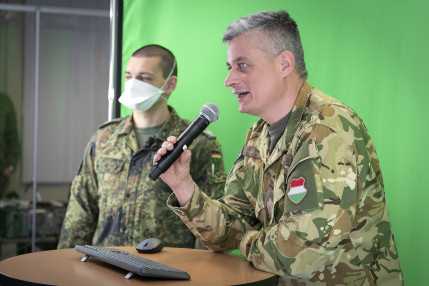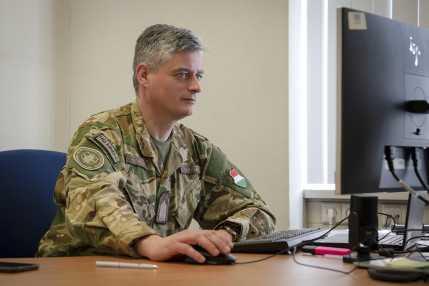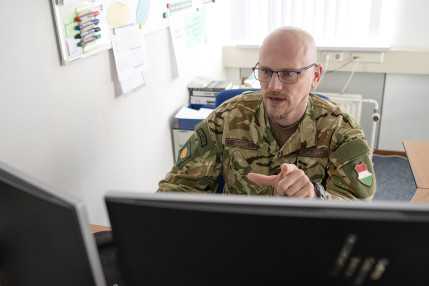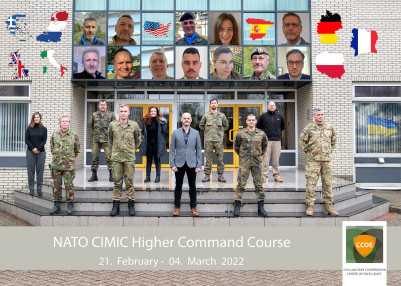With the participation of Hungarian instructors, the highest level course in NATO's Civil-Military Cooperation (CIMIC) discipline was held at the NATO CIMIC Center of Excellence (CCOE) in The Hague, the Netherlands, from 21 February to 4 March. We asked one of the instructors, Lieutenant Colonel Tamás Harmath, Assistant Chief of Staff (non-kinetic) of Headquarters Multinational Division Centre, about the NATO CIMIC Higher Command Course and the situation in the civil-military cooperation domain.

Exactly what is this course about and on what level was it held?
The NATO CIMIC Higher Command Course is the highest level course in NATO civil-military cooperation in the current education portfolio, held twice a year for two weeks. The course is essential for all those serving in NATO Strategic and Joint Force Commands or leading and planning CIMIC-related tasks in higher tactical level headquarters belonging to NATO Force Structure. In the course, we primarily teach the procedures of joint operational level, but in each case the lecturers point out how the given knowledge can be adapted at higher or lower levels. With regards to the topics taught, the entire scale of tasks, as well as the full range of related CIMIC support tasks are intended to be presented to the students. The organizers of the course place special emphasis on getting to know and practice the process of operation planning. Under the guidance of syndicate leaders, the students prepare the incorporations of the CIMIC field for each phase in working groups. Moreover, they can learn about the related tasks of the CIMIC in the so-called cross-functional areas, such as national resilience, the protection of civilians and cultural property, and the protection of children and women during armed conflict.
During the practical part, within the framework of a realistic scenario, all the tasks are included that the students have to perform in syndicate work with the acquired knowledge, so that they have the opportunity to learn not only from the instructors but also from each other. Due to the current situation of the COVID-19 pandemic, this method of teaching has changed so the course organizers have opted for the online format, with the instructors gathered in CCOE and the students joined from home or work.

What is the significance of CIMIC?
In the midst of the current complex security challenges, I believe that this area is of paramount importance. CIMIC is a combat support capability designed to put the principle of comprehensive approach into practice within the military. It shall co-operate with non-military actors in the area of operation and seeks mutual support both for the objectives of military and non-military actors. It provides the commander with a comprehensive view of the civilian situation at all times, which is essential for the planning and execution. Just think of the perception of military when in today's conflicts the media broadcasts in real time to the world's public about civilian facilities becoming military targets (there are plenty of practical examples for this in the ongoing Ukrainian-Russian war). The same is valid if the military does not provide the expected assistance to prevent disasters and eliminate the consequences of certain humanitarian catastrophes. Such cases can fundamentally and negatively affect the credibility of the military force and the acceptance of military operations.
CIMIC, as a military capability is relatively new, it appeared in this form within NATO and its member states during the Balkans War. In the initial period, it was identified only with the peacekeeping tasks, but it is given an equally prominent role in national defense tasks and collective defense operations.

What are the responsibilities of the CCOE?
The CCOE is the ”alma mater” for NATO CIMIC professionals. It deals with the elaboration and development of the doctrine, related concepts and other regulations, it operates NATO's training system specialized in CIMIC, and supports the work of those working in the field with a range of scientific and practical studies, analysis and manuals. Hungary joined the organization 12 years ago, and since then, in rotation, a Hungarian staff officer serves as the Deputy Head of the Concepts, Interoperability and Capabilities Branch in CCOE. This time, Major Csaba Szabó and I were among the instructors. I believe that the fact that two of the five instructors in the course belong to the Hungarian Defence Forces is a good example of the international prestige of the Hungarian CIMIC capability.

What professional background is required to teach in such high level course?
I joined the Hungarian Defence Forces Civil-Military Cooperation and Psychological Operations Centre in 2005, where I had the opportunity to master the basics of this field and to put the gained knowledge into practice during exercises and international peace support missions. During my time there, until 2012, I participated in the work of the Hungarian Provincial Reconstruction Team in Afghanistan three times, and already got in touch with CCOE during the organization of NATO CIMIC courses in Hungary. From 2012 to 2016, I served as a CIMIC Planner at NATO’s Allied Joint Force Command in Brunssum. In addition to the new challenges, this period brought me plenty of new professional experience and knowledge, and, partly due to this, I have been invited in 2020 and now to support the above-mentioned course as an instructor. Returning from Brunssum, between 2016 and 2019 I held position at superior CIMIC body of the Hungarian Defence Forces Joint Force Command (later Hungarian Defence Forces Command), and in 2019 I was invited to contribute to a new organization, soon to be a NATO entity, as the head of CIMIC and non-kinetic field at the Headquarters Multinational Division Centre in Székesfehérvár, Hungary.
